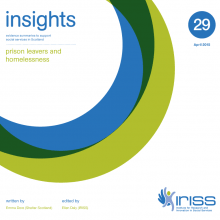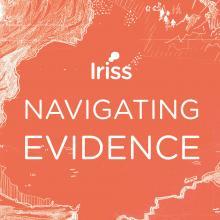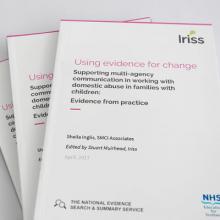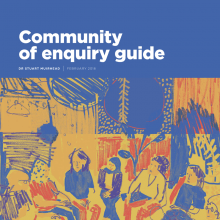This Insight looks at the evidence around effectively involving those in seldom-heard groups.
Key points
- People in seldom-heard groups face multiple barriers affecting access to and use of social services
- A positive staff attitude can help to facilitate better participation of people from these groups
- Good relationships and honest communication between staff and seldom-heard people who use services underpin effective models of participation
- An 'everyday' approach to participation, where there is no distinction between participation and service delivery, is most effective in supporting seldom-heard groups
Seldom-heard groups
The term 'seldom-heard groups' refers to under-represented people who use or might potentially use social services and who are less likely to be heard by social service professionals and decision-makers. They are often referred to as 'hard to reach' groups, though this term has been criticised for implying that there is something about these people that makes their engagement with services difficult. 'Seldom- heard' places more of the emphasis on agencies to engage these service users, carers and potential service users.
Many factors can contribute to people who use services being seldom-heard, including:
- Disability
- Ethnicity
- Sexuality
- Communication impairments
- Mental health problems
- Homelessness
- Geographical isolation
Policy context: Scotland
There has been an increasing shift towards social services that are centred around the person who uses services. This agenda is reflected in Personalisation: A shared understanding (Scottish Government, 2009) and Self-Directed Support: A National Strategy for Scotland (Scottish Government, 2010). It also relates to Changing Lives: Report of the 21st Century Social Work Review (Scottish Government, 2006), which outlined the future of social services in Scotland. Together, these policies promote empowerment, flexibility, choice and control for people who use services.
Research evidence: key issues and barriers
According to the Social Care Institute for Excellence (SCIE, 2006), mainstream service user participation in social care has increased over the last 20 years. However, participation of black and minority ethnic (BME) people has diminished over this period of time, even though there is no evidence to suggest these service users do not want to participate. BME service users have reported feeling that mainstream services were often inappropriate; that services made assumptions based on stereotypes and prejudice; religious and cultural identity was rarely responded to by mainstream service providers; and that common myths about informal family networks looking after each other should not be taken for granted (Chahal and Ullah, 2004). Stereotypical views of black people, racism, stigma and cultural ignorance were also seen to affect responses from mental health services to the needs of African Caribbean communities (Sainsbury Centre for Mental Health, 2004).
SCIE was commissioned by the Department of Health to consult on the Green Paper Independence, well-being and choice: Our vision for the future of social care for adults in England with service users (or potential service users) who are seldom-heard (2005). Involved in the consultation were:
- Homeless people and people with chaotic lifestyles (people with multiple substance abuse and mental health problems)
- BME people who do not have a national or other organisation that might represent their views refugees and asylum seekers
- People with severe learning disabilities and / or communication impairments
The consultation highlighted several key barriers and circumstances affecting these groups:
- Many people in the various groups were preoccupied with attempting to fulfill their basic needs, limiting the extent to which they could fully consider wider issues.
- Among participants there was a low awareness of services and/or a suspicion of statutory provision, though services provided by voluntary organisations were well liked.
- Difficulties accessing community services revolved around factors such as language barriers, societal discrimination, fear, legal status, financial issues, lack of information and/or culturally appropriate resources, feelings of isolation from the community.
- There was a fairly low understanding of the concept of assessment and ideas of self-assessment were not well received. Among the participants there were concerns about sharing information between agencies.
- There was also fairly low awareness of direct payments. Barriers to uptake included financial management, knowledge of possible services, language barriers and literacy.
- Participants outlined several key qualities they wanted in social care staff, including being non-judgmental, friendly, able to listen, committed, good communicators and service user-centred and carer-centred in their approach.
Adapted from SCIE (2005)
In a further study, SCIE (2008a) identified a range of obstacles experienced by seldom-heard people who use services including attitudinal, organisational, cultural and practical barriers. Attitudinal barriers included 'staff treating adults using services as if they were inferior' and a 'perception that some staff do not believe in the potential of the people they are supporting' (p13). The attitudes of the public were also problematic, with service users experiencing harassment on public transport.
Organisational barriers that impacted on seldom-heard groups included 'difficulty in finding people to engage with, especially when service use is episodic and service users have transient lifestyles' and 'the emphasis on meetings, excluding people who operate better in other situations' (p13). Several organisational barriers focused on issues of communication, for example:
- Not enough thinking time for some people with impairments
- Communication in meetings too fast for some communication methods
- Too much reliance on computer-based communication and reference to websites, and not enough thought given to other forms of communicating
- Practicalities of communication, for example, cost, technology, training, skills
- Content of communication, for example, the extent to which different parties have different perspectives or are on different wavelengths
Cultural barriers were also significant. Concern about being labeled a 'service user', 'fear that complaining or criticising services will jeopardise the service or an individual's access to it' and individual perceptions that a service or group is 'not for me' were highlighted (SCIE, 2008a p13).
In addition, several practical barriers were identified including:
- Lack of interpreters
- Lack of information about rights and services
- Poor acoustic environments for communication, for example too much background noise
- Lack of accessible transport and finance for it
- Documents that are too long, complicated and not in plain language
- Difficult group dynamics and relationships between people who use services becoming a disincentive for some service users: for example, one or two dominating persons
- Lack of clarity about, for example, how much power and influence a group of people who use services has within an organisation
- 'Picking and choosing' service users to 'get the right answers', for example, in meetings with MPs
Taken from SCIE (2008a p13-14)
What works?
SCIE's study (2008a) suggested several key ways to address barriers, emphasising the importance of clear and supportive communication:
- Treating people with respect and valuing individual contributions
- Describing clearly what someone can expect from getting involved and what they are expected to contribute
- Making sure people know they can say 'no' to getting involved
- Offering a variety of activities and ways to get involved, such as helping others, learning, socialising
- Allocating sufficient resources for communication, transport, meetings, support and payment
Taken from SCIE (2008a p14)
In their research with black and minority ethnic disabled children, the Centre for Excellence and Outcomes in Children and Young People's Services (2009) found several factors contributed to positive outcomes for this group including:
- Collaborative relationships between families and services which recognise cultural differences
- Language and culturally- specific information
- A diverse workforce
- Provision of interpreting and translation services
The Hearing from the Seldom Heard project (British Institute of Learning Disability, 2009) also highlighted the importance of good relationships and clear communication. Working with people with profound and multiple learning disabilities, people who have behaviour described as challenging, and people with complex communication needs, the project made six key recommendations:
- Getting to know people really well: good person-centred thinking and planning
- Learning to communicate better with those people that are seldom-heard
- Raising awareness of the human rights of people who are seldom-heard, including the right to complain
- Ensuring access to appropriate advocacy
- Ensuring access to complaints buddies: somebody to take action on behalf of the seldom-heard service user
- Making use of effective complaints procedures: families, support staff and complaints buddies need to know how to use these systems effectively
Adapted from BILD (2009)
The Scottish Consortium for Learning Disability (SCLD) conducted the What's out there? project (2010) to find out about support services for people with learning disabilities and their families from black and minority ethnic communities. Their research found that:
...whilst it may be challenging for most organisations to work effectively with people with learning disabilities and family carers from the black and minority ethnic communities, the Chinese and African and Caribbean communities were cited as two particularly hard to reach communities (p39).
A number of good practice initiatives were identified by the research including:
- Staff who can speak the language of the people who uses services
- Cultural diversity training for staff and volunteers
- Promotion of cultural diversity to staff, users and communities
- Ensuring equalities are a 'core standard'
- Recruiting volunteers from BME communities
The project also made a number of recommendations around improving communication and information, enhancing connections with communities and agencies, building organisational capacity and planning for the future for BME people with learning disabilities.
To improve access to and sharing of information, the report suggested 'a model of communication which checks out whether the information shared has been received and properly registered (within people's understanding)' (p58). Further recommendations included:
- Providing language support
- Harnessing multimedia to get messages across to communities (eg drama/forum theatre, videos/DVD and documentaries)
- Building relationships with the BME led media/press and using it to deliver messages
- General awareness raising in appropriate formats to shift negative attitudes around the subject of learning disabilities
To enhance relationships with people and agencies the report highlighted the importance of:
- Connecting with people in their own environment
- Developing outreach components to projects / initiatives
- Continuing and enhancing the Local Area Coordinator model
- Partnership working between mainstream organisations and BME led agencies
- Partnerships across rural and urban local authorities
To build organisational capacity, the research suggested:
- Using role models to present stories about their experiences relating to learning disability issues as a means to challenge myths and stereotypes
- Contracting processes between statutory and voluntary agencies to ensure organisations that are commissioned can demonstrate their services are inclusive and accessible to everyone including people with learning disabilities from BME communities
- Conveying a welcoming environment through inclusive images, posters and welcome signs in different languages
In their study, SCIE (2008b) made several recommendations for supporting seldom- heard groups, including the development of 'champions' in organisations for lesbian, gay, bisexual and transgendered people; supporting isolated service users through technological means eg teleconferencing; and enabling people with communication impairments through loop systems, signers and support workers. Talking Mats can also help involve people with communication difficulties or dementia in decision- making. These simple communication tools use picture symbols on a textured mat for people to indicate their views about various options within a topic.
A study by the Joseph Rowntree Foundation (2010) found 'that people with dementia and their family carers both feel more involved in discussions when using Talking Mats, compared to their usual communication methods. They also feel more satisfied with the outcome of these discussions' (p2).
Implications for practice
Positive relationships between staff and people who use services are vital to engaging and involving seldom-heard groups in services. An inclusive, non-judgmental and respectful staff attitude toward seldom-heard service users (and potential users) helps to enable participation (SCIE, 2005; SCIE 2008a). When staff attitudes are negative, this acts as a significant barrier to the involvement of seldom-heard people with the services they receive or might potentially receive. Staff need to act as allies, advocates and brokers, without discharging their responsibilities, and to be honest about circumstances when participation in decision-making has to be limited because of legal and professional obligations of workers (eg childcare proceedings) (SCIE, 2006).
A shift in practice to an 'everyday' model of participation, where there is no distinction between participation and service delivery, is most effective in supporting the involvement of seldom-heard groups and also makes strategies for overcoming practical barriers easier. This model is underpinned by strong relationships between staff and people who use services (SCIE, 2008a). Staff reported in the study that time and money were key enablers to the 'everyday' approach, as they facilitated trust and good relationships with services users. People who use services agree the importance of working together with staff to promote meaningful service user involvement: 'try not to see it as a 'Them and Us' situation. We need to be working together and listening to each other' (Branfield and Beresford, 2006 p82).
If social services are to become more personalised to the needs of all people who use services, those in seldom-heard groups need to be better supported to overcome the attitudinal, organisational, cultural and practical barriers affecting access to and use of services that they face. The evidence in this summary outlines the activities, attitudes and an approach to practice that social services professionals can adopt to help enable the participation of seldom-heard groups.
References
- Branfield F and Beresford P (2006) Making user involvement work: supporting service user networking and knowledge, York: Joseph Rowntree Foundation
- British Institute of Learning Disability (2009) Hearing from the Seldom Heard, Kidderminster: British Institute of Learning Disability
- Centre for Excellence and Outcomes in Children and Young People's Services (2009) Ensuring all disabled children and young people and their families receive services that are sufficiently differentiated to meet their diverse needs, London: Centre for Excellence and Outcomes in Children and Young People's Services
- Chahal K and Ullah A (2004) Experiencing ethnicity: discrimination and service provision, York: Joseph Rowntree Foundation
- Joseph Rowntree Foundation (2010) Talking Mats help involve people with dementia and their carers in decision-making, York: Joseph Rowntree Foundation
- Sainsbury Centre for Mental Health (2004) Breaking the Circles of Fear: a review of the relationship between mental health services and African and Caribbean communities, London: Sainsbury Centre for Mental Health
- Scottish Consortium for Learning Disability (2010) What's out there? Glasgow: Scottish Consortium for Learning Disability
- Scottish Government (2006) Changing Lives: Report of the 21st Century Social Work, Edinburgh: Scottish Government
- Scottish Government (2009) Personalisation: a shared understanding, Edinburgh: Scottish Government
- Scottish Government (2010) Self-Directed Support: A National Strategy for Scotland, Edinburgh: Scottish Government
- Social Care Institute for Excellence (2005) I'm not asking to live like the Queen: the vision of service users (or potential service users) and carers who are seldom heard on the future of social care for adults in England, London: Social Care Institute for Excellence
- Social Care Institute for Excellence (2006) Doing it for themselves: participation and black and minority ethnic service users, London: Social Care Institute for Excellence
- Social Care Institute for Excellence (2008a) Seldom heard: developing inclusive participation in social care, London: Social Care Institute for Excellence
- Social Care Institute for Excellence (2008b) The participation of adult service users, including older people, in developing social care, London: Social Care Institute for Excellence






